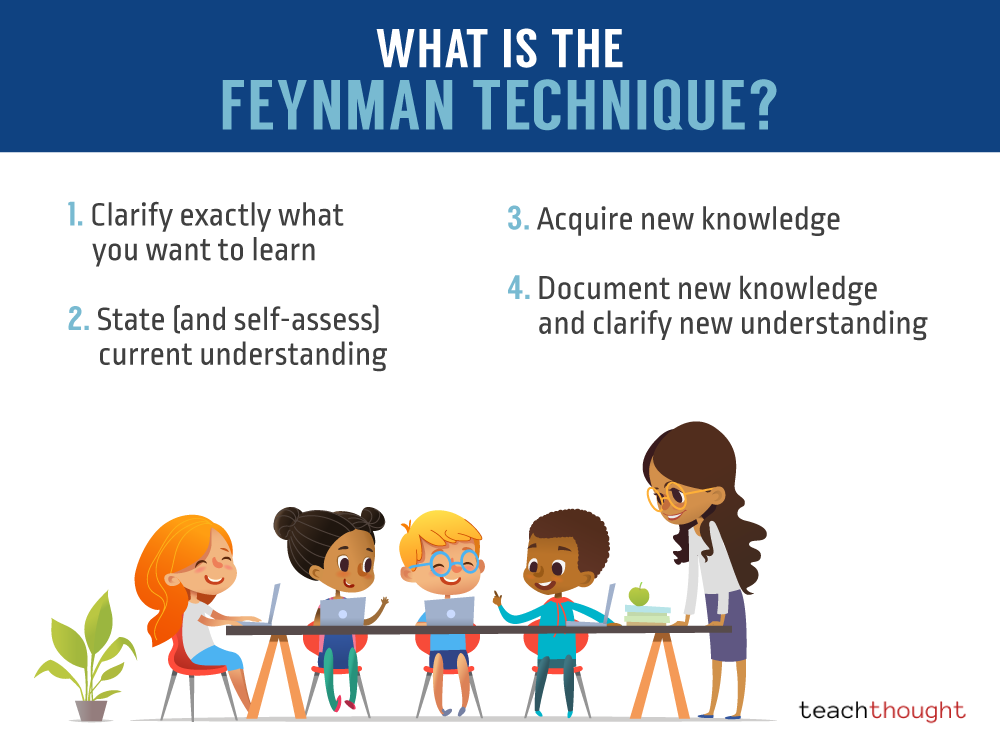
The Feynman Technique: An Overview
by Terry Heick
What is The Feynman Technique?
In short, it’s a simple approach to self-directed learning that is based on distilling what you know. Albert Einstein is often credited with having said that (paraphrasing) “you don’t know something well if you can’t explain it to a child.”
And that’s the Feynman Technique in a nutshell.
The technique is named after Richard Feynman (May 11, 1918 – February 15, 1988) an American theoretical physicist, who was involved, among efforts, in the Manhattan Project and has a background in doing exactly what you might expect: teaching himself complicated ideas. An accomplished scientist, Richard Feynman was known as the ‘great explainer’ for his ability to translate complex scientific theories into more accessible terms, was accomplished in quantum computing and particle physics, and nanotechnology–as well as winning the Nobel Prize in Physics in 1965 for his work in quantum electrodynamics.
For this post, we’re mostly interested in his contributions to learning itself, and Wikipedia helpfully offers some background.
When Feynman was 15, he taught himself trigonometry, advanced algebra, infinite series, analytic geometry, and both differential and integral calculus. Before entering college, he was experimenting with and deriving mathematical topics such as the half-derivative using his own notation. He created special symbols for logarithm, sine, cosine and tangent functions so they did not look like three variables multiplied together, and for the derivative, to remove the temptation of canceling out the {displaystyle d}
Learning By Simplifying: How To Use The Feynman Technique
There is, of course, a difference between knowing something and knowing the name of something and that’s where understanding types of knowledge is crucial.
In order to understand something, you should be able to explain it briefly and accurately but in order to do that, you need to understand the kinds of things a person can and might know (declarative knowledge versus procedural knowledge, for example).
That’s a topic for another day. Today is about Feynman and his approach to learning: If you can’t explain something to a child, there’s a chance you don’t understand it well and by coming to be able to explain it briefly and accurately, you’ll be learning.
The video above from Thomas Frank at collegeinfogeek.com offers a nice overview of the Feynman Technique and below, I itemized the steps of this simple approach to learning.
Note, I did take some artistic liberty by focusing a little more on documenting the process of learning by adding in the documenting how your knowledge has changed (part of step 4) rather than simply on continuously restating your understanding in simple terms. If you want to stick purely to the original form of the Feynman Technique as the good scientist intended, refer to this video more than my crude itemizing below.
How Do You Use The Feynman Technique?
1. Clarify exactly what you want to learn
Clarify the concept you want to understand and write it at the top of a blank piece of paper. The more specific you are, the cleaner and more efficient the rest of the learning process can be.
2. State (and self-assess) current understanding
In the plainest language possible, write down an explanation of the idea as if you were teaching it to someone who does not understand it at all
Note, it’s fine to start out with a broad summary and then get more specific, working through examples, scenarios, or other subtleties of the concept. Simply stating it broadly isn’t enough to fully demonstrate ‘understanding’ but rather is a kind of ‘foothold’ to work from as you do demonstrate that understanding.
3. Acquire new knowledge
What is the Feynman Technique? In the broadest possible sense, it’s about learning–acquiring new knowledge. If you can’t explain it fully, go back and reread, research, and relearn source material until you feel more or less confident in your explanation.
Note, if we lack expertise it can be difficult to know what we do and don’t know so this part isn’t perfect. However, as you become accustomed to the technique–and self-directed learning in general–you can develop a better instinct for what you do and don’t understand–and of the latter, what’s most important and where you should start.
4. Document new knowledge and clarify new understanding
As you gain new knowledge, reflect on and document new knowledge–especially how your understanding has changed.
Creating visuals, concept maps, and any of the various types of analogies (here’s a guide for teaching with analogies) is a useful way to clarify your own thinking. In short, you’re trying to–with both accuracy and precision–demonstrate a more or less complete understanding of the topic you’re trying to learn with the Feynman Technique.
As your understanding changes, your demonstration of that understanding should change. This will both deepen your understanding of the topic as well as illuminate the learning process itself (which can carry over into learning about new topics).
5. Restate evolved understanding (i.e., as compared to step 2)
Once you’ve ‘done the work’ of learning, try to–without checking your paper or other research notes or documentation–state your understanding again–from scratch and without reference. If you can’t, go back and repeat steps 3 through 5.
Learning By Simplifying: How To Use The Feynman Technique; What Is The Feynman Technique?